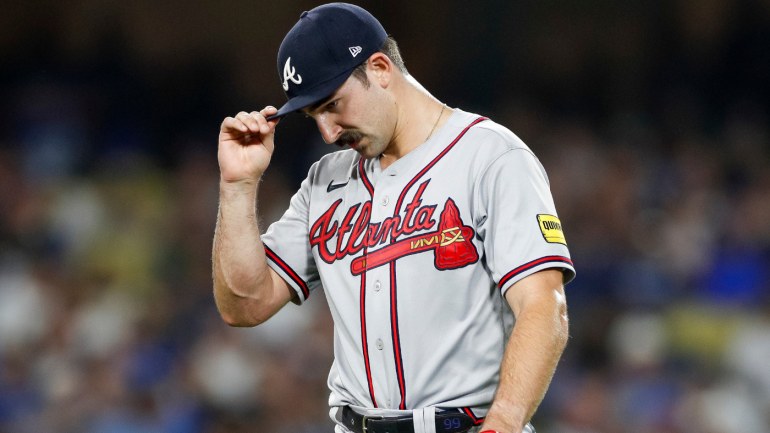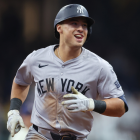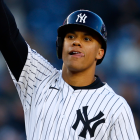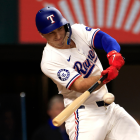
The last week or so has been very bad for baseball. Miami Marlins wunderkind Eury Pérez and Cleveland Guardians ace Shane Bieber both went down with torn elbow ligaments that will require season-ending surgery, as did Yankees reliever Jonathan Loáisiga. Atlanta Braves righty Spencer Strider has a damaged ligament as well. He may be headed for his second career Tommy John surgery. Astros lefty Framber Valdez was scratched from his Monday start with elbow soreness.
Last season, 34.2% of pitchers to appear in an MLB game had Tommy John surgery at some point in their past, according to researcher Jon Roegele. That number was 34.0% in 2022, 30.5% in 2021, and 29.8% in 2019, the last full season before the pandemic. The number keeps going up because pitcher injuries keep going up. It's an epidemic.
Injuries have been part of baseball as long as there has been baseball, though pitcher injuries have been on the rise in recent years. There were 132 pitchers on the major league injured list on Opening Day this year, or 80% of the 166 injured list assignments. Go back to 2019, and pitchers made up less than 68% of Opening Day injured list assignments.
Pitching injuries are on the rise and there is no one single reason to explain it. It is a combination of multiple things and that's what will make coming up with a solution so difficult. Here, in no particular order, are four possible reasons pitching injuries are at an all-time high.
1. Pitch clock
We might as well start here because MLB Players Association executive director Tony Clark specifically blamed the pitch clock for the uptick in pitcher injuries in his statement over the weekend. Here's Clark:
Despite unanimous player opposition and significant concerns regarding health and safety, the Commissioner's Office reduced the length of the pitch clock last December just one season removed from imposing the most significant rule change in decades.
Since then, our concerns about the health impacts of reduced recovery time have only intensified.
The league's unwillingness thus far to acknowledge or study the effects of these profound change is an unprecedented threat to our game and its most valuable asset -- the players.
MLB shot back, citing an analysis by Johns Hopkins University that showed no correlation between the pitch clock and injury risk. That analysis is not public, however, which means we're being asked to give MLB the benefit of the doubt.
Anecdotally though, yes, of course the pitch clock could be contributing to the increase in pitcher injuries. It affords pitchers less recovery time between pitches and thus they are making more pitches while fatigued. Greater fatigue equals greater injury risk. That is true if you're throwing a baseball, lifting weights, riding a bike, whatever.
It would be silly to dismiss the pitch clock as a potential reason for the rise in pitcher injuries. That said, the pitch clock is not going away. It is the best thing to happen to the sport's aesthetics in a long, long time. Games flow so much better and downtime has been drastically reduced. Like it or not (the MLBPA doesn't), there's no going back now.
2. Max effort pitching
It is remarkable how much velocity is in the game today. Not just fastballs either. Turn on a game on any given night and you have a chance to see a guy slinging 93 mph sliders. Spin has increased too. Statcast launched in 2015, so this is the 10th year recording data. Look at the league fastball velocity and breaking ball spin in April of each year (ignoring 2020 for obvious reasons):
| Fastball velocity | Breaking ball spin | |
|---|---|---|
April 2015 | 92.6 mph | 2,156 rpm |
April 2016 | 92.8 mph | 2,367 rpm |
April 2017 | 93.0 mph | 2,412 rpm |
April 2018 | 92.7 mph | 2,439 rpm |
April 2019 | 93.2 mph | 2,461 rpm |
April 2021 | 93.6 mph | 2,490 rpm |
April 2022 | 93.7 mph | 2,428 rpm |
April 2023 | 93.8 mph | 2,460 rpm |
April 2024 | 94.0 mph | 2,458 rpm |
I'm not quite sure what happened in 2018, but that year is an outlier, and velocity has been steadily increasing. That is true not only during the Statcast era, but throughout baseball history. Pitchers today throw harder than they did 10 years ago, and 10 years ago pitchers threw harder than they did 10 years before that. On and on we could go.
The sport inherently rewards velocity and spin, so teams and pitchers chase it. Bieber, after averaging a career worst 91.3 mph with his fastball last season, trained at Driveline this offseason, and his fastball jumped to 92.0 mph in his two starts before his elbow gave out. He was chasing velocity and he found it, then he got hurt. Is there a correlation? Maybe, yeah.
Shane Bieber (@ShaneBieber19) wrapped up his off-season @DrivelineBB with a bang!
— Chris Langin (@LanginTots13) February 10, 2024
🚀 Average 93.2 MPH
10 heaters > 93 MPH, surpassing his entire 2023 (8).
🌀 Curveball revived
Session: 83.7 MPH | 14" VB
2020🥇: 83.6 MPH | 14" VB
Looks like he's back in business... 🔥 pic.twitter.com/C2ykEyyX0K
The neverending chase for velocity and spin has led to pitchers throwing max effort all the time -- starters no longer leave a little something in the tank for later in the game -- which leads to shorter outings, and a parade of relievers also throwing max effort on every pitch. Baseball has morphed into 4-5 pitchers per team throwing as hard as they can every night.
It is a vicious cycle. If you don't have velocity and spin, you get left behind, and we're talking about livelihoods here. If throwing as hard as you can is what it takes to get to the big leagues and get paid, players will do it. And if a team tries to teach their pitchers to hold something back and "pitch" more than "throw," for lack of better terms, they'll find themselves at the bottom of the standings.
Point is, the game rewards a pitching style that is inherently dangerous to the arm. Throwing a baseball overhand is an unnatural movement as it is. Pitchers do it as hard as they can over and over, and it's a miracle more of them don't get hurt, really. If you don't have velocity and spin, you get stuck behind the guys that do.
"I think the biggest thing is that the style of pitching has changed so much. Everyone is throwing the ball as hard as they possibly can and spinning the ball as hard as they possibly can," Justin Verlander said over the weekend. "... It's a double-edged sword. How can you tell somebody to not do that when they're capable of throwing 100 mph? Something needs to change."
3. Foreign substances
In the table above, did you notice the average breaking ball spin steadily increased from 2015-21 before declining in 2022? That's because MLB cracked down on foreign substances in June 2021, and spin rates declined across the league. Pitchers used foreign substances to generate the kind of spin they could not generate naturally. Again, they're chasing what the game rewards.
Soon after the foreign substance crackdown in June 2021, current Los Angeles Dodgers pitcher and then Tampa Bay Rays ace Tyler Glasnow blamed it for his torn elbow ligament and Tommy John surgery. Here's what Glasnow said at the time:
"I just threw 80 something innings and you just told me I can't use anything. I have to change everything. I truly believe 100% that's why I got hurt. I'm frustrated MLB doesn't understand. You can't just tell us to use nothing. It's crazy."
Injuries did not spike in the immediate aftermath of the foreign substance crackdown -- Glasnow later revealed his elbow hadn't been fully healthy since 2019 -- but perhaps there's a delayed reaction? The added strain of trying to generate the spin that came easily with foreign substances gradually damaged the arm over time in a way it wouldn't have with sticky stuff.
Of course, if pitchers are using a foreign substance to generate spin and movement they can not generate naturally, that is textbook cheating, and MLB was smart to get rid of it. Pitchers have enough advantages as it is. Still, there is a chance the crackdown is now contributing to the rise in injuries. There is, at least in theory, fewer methods available to gain spin.
4. Specialization at the amateur level
Perfect Game USA is the industry leader in amateur baseball and softball events, and you can go to Perfect Game's website right now and get information on kids who won't be draft-eligible until 2028. We're talking about 13- and 14 year-old kids. There are scouting reports with their fastball velocity and ability to spin a breaking ball and all sorts of stuff along those lines. The travel team rankings start with 9 and under.
These are children. They are not yet close to physical maturation, and yet they are being trained to throw hard and are being ranked by industry leaders based on these skills. This happens all throughout the amateur ranks, both in high school and college (and Little League?). Kids are reaching pro ball with more wear and tear on their arms than ever before.
The focus is on big name MLB elbows, but what should get as much attention/concern are 16-year-old studs having UCL reconstructions now. They'll be throwing 100+mph in the big leagues with old ligaments 10 years from now. That's how this perpetuates. We HAVE to think upstream.
— Eric Cressey (@EricCressey) April 8, 2024
That is Eric Cressey, president of Cressey Sports Performance and the director of player health and performance for the New York Yankees. Countless players have trained at his facility and also rehabbed from major injuries at his facilities. Arm injuries are not limited to the pros. This problem starts at the amateur level. The solution will have to start there as well, and it will require MLB and the MLBPA working together, not bickering publicly.






















